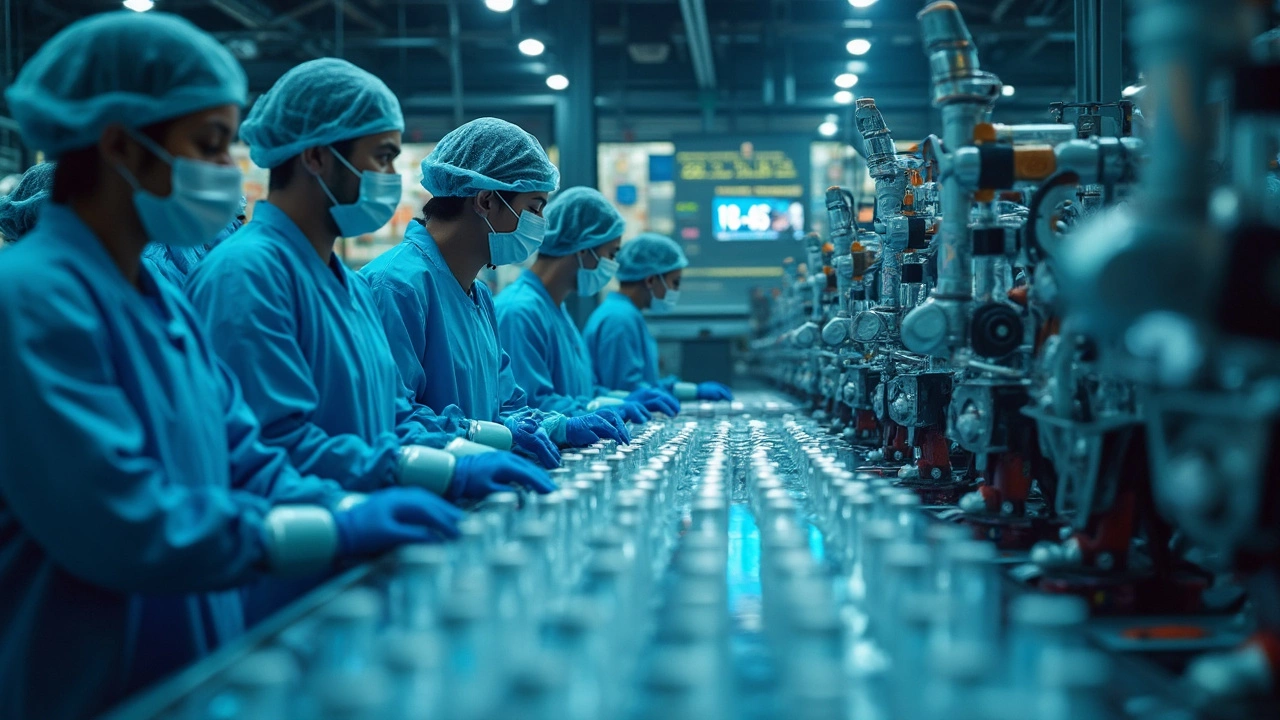You hear a lot about India churning out low-cost meds for the world, but the real story isn’t just about price—it’s about the sheer scale and quality of its pharma manufacturing. Some plants rival the likes of the US and Europe. Big names like Sun Pharma, Cipla, and Dr. Reddy’s don’t just build huge factories for the sake of it—they invest in advanced tech, robust safety checks, and super-clean facilities that regular folks would picture more like labs than old-school factories.
Standards here are no joke—plants that export to Europe or the US must clear strict audits by the US FDA or European regulators. Ever wondered why India is called the “pharmacy of the world”? Around 60% of vaccines supplied globally are made here. The backbone? Massive plants mostly in states like Gujarat, Maharashtra, Andhra Pradesh, and Telangana. Some plants can churn out millions of pills, injectables, or ointments daily—and still have the paperwork airtight.
If you’re eyeing the pharma sector—whether for jobs, business, or just curiosity—the plants we’re about to talk about are the real benchmarks. Stick around to get a sense of what goes on inside these giants and why they’re at the top of the pile, from robot-packed assembly lines to zero-contact packaging zones.
- What Sets India’s Top Pharma Plants Apart?
- Spotlight on Leading Pharma Plants Across India
- Quality Control: How These Plants Raise the Bar
- Impact on the Economy and Global Healthcare
- Tips for Visiting or Working with Leading Pharma Plants
What Sets India’s Top Pharma Plants Apart?
You can find factories all over, but India’s best pharma plants break the mold. These places are packed with modern tech and run like clockwork. It's not just about churning out tons of pills – it's about getting the quality right every single time. The pharma plants India is known for are obsessed with consistency because a little slip-up could shut down exports to Europe or the US.
Most of the top plants are certified by US FDA, WHO-GMP, and EMA (European Medicines Agency), which isn’t easy. They have to run quality checks at nearly every stage, from raw material testing to boxing up the final tablets. Mistakes? The system is lined with double and triple-checks so you won’t find a bad batch sneaking through.
- Automated assembly lines cut down on human error and contamination.
- Cleanrooms with temperature and humidity controls keep everything sterile.
- Data gets logged round-the-clock for full traceability. If something goes wrong, they can trace it back in seconds.
- Plants use waste management setups to recycle water and limit air pollution—especially in big facilities in Hyderabad and Ahmedabad.
One standout fact—Hyderabad alone hosts more than 800 pharma manufacturing units, known as the "Bulk Drug Capital of India." Plants here produce active pharmaceutical ingredients (APIs) by the ton for companies everywhere.
| Feature | Why It Matters |
|---|---|
| US FDA Approval | Makes exports to US and Europe possible |
| Fully Automated Production | Reduces mistakes and boosts efficiency |
| Traceability Systems | Every ingredient logged—makes recall easy if needed |
| Environmental Controls | Keeps products safe and meets global regulations |
What really sets these plants apart? They’re not just following orders—they’re leading the charge with new tech, fast product turnarounds, and waste-cutting green policies. You won’t see these standards everywhere else, and that’s what makes them a step ahead.
Spotlight on Leading Pharma Plants Across India
If you look at the list of pharma plants India relies on, a few big names stand out, not just for their size but for how much medicine they pump out daily. Some of these factories supply big hospitals in India, while others load up containers for Europe, America, or Africa. It’s wild to think a pill made in a small town in Gujarat can end up on a pharmacy shelf in Berlin or New York City.
Let’s break down where the real action happens:
- Sun Pharmaceutical Industries, Halol, Gujarat: This plant is famous for surviving some tough US FDA inspections. The Halol facility is massive, covering nearly 70 acres, and it handles everything from tablets to injectable drugs. It’s one of Sun Pharma’s key sites for exports.
- Dr. Reddy’s Laboratories, Bachupally, Telangana: Not just a manufacturing hub—this plant also invests bigtime in research. It’s where tons of generic medicines are made before heading out to US and European markets. Their Bachupally facility is known for automation, reducing manual errors right from mixing raw materials up to shipping the final product out.
- Cipla, Patalganga, Maharashtra: Cipla has several plants, but Patalganga is their pride. It’s the one that churns out bulk drugs, tablets, and even inhalers. Fun fact: Cipla played a major role during the HIV crisis by making affordable antiretroviral tablets here.
- Lupin, Mandideep, Madhya Pradesh: This plant is a major producer of antibiotics, especially cephalosporins. The Mandideep unit is fully certified by European and Japanese regulators, making it a go-to for international buyers.
- Aurobindo Pharma, Hyderabad, Telangana: Their Unit III in Hyderabad is a behemoth, handling both oral and injectable forms. It’s part of the reason Aurobindo can fill huge export orders to the US every year.
Each of these factories isn’t just about production—it’s about global reach and ticking every box for quality. Most use automated lines, have their own power plants, and run 24/7. If you’re ever close to these areas, you’ll see entire townships built around these plants, powering local economies along the way.

Quality Control: How These Plants Raise the Bar
Quality isn’t an afterthought in Indian pharma plants—it's the main show. You can’t just pump out pills and hope for the best. Each batch, whether it’s for local use or being shipped thousands of miles away, has to tick off a laundry list of checks. Plants like those of Sun Pharma and Aurobindo Pharma go through hundreds of quality inspections. Their labs regularly perform tests on raw materials, checking purity and potency before anything even gets to the production line.
Want an idea of just how tight these controls are? Take the US FDA, which inspects over 200 Indian pharmaceutical facilities every year. Plants aiming to send medicines abroad deal with strict rules: stability testing in real-life heat and humidity, detailed tracking of every tablet, and digital record-keeping so nothing slips through the cracks.
Top pharma manufacturers also use cutting-edge tech to reduce human error. Automation means you’ve got robots weighing, mixing, and packaging drugs—all with a level of consistency humans can’t match. Plus, the air inside these plants is filtered to meet hospital-grade standards. The rooms stay pressurized and staff wear special clothing, keeping medicines safe from any contamination—no shortcuts.
If you’re wondering what all these checks really look like, here’s a taste:
- Raw materials tested before they’re accepted
- 24/7 environmental monitoring in cleanroom areas
- End-of-line tests for every batch—checking strength, purity, and packaging seal
- Barcode systems to track products across the supply chain
Here’s a quick look at some hard numbers that show the scale of quality control:
| Plant | No. of Annual Batches * | Avg. Quality Checks per Batch |
|---|---|---|
| Sun Pharma, Halol | 15,000+ | 400+ |
| Dr. Reddy’s, Bachupally | 12,500 | 350 |
| Lupin, Tarapur | 9,800 | 300 |
*Numbers are taken from industry disclosures and recent annual reports.
All these controls aren't just about ticking boxes—they keep Indian pharma plants on global shelves and patients safe, every single dose.
Impact on the Economy and Global Healthcare
India’s pharma plants do much more than just mix chemicals and pack pills—they’re heavyweights in both the economy and health of millions around the globe. Get this: the Indian pharmaceutical industry shipped out medicines worth $25 billion in the last reporting year, reaching over 200 countries. That's not a random stat—it’s a direct result of having so many high-output, efficient plants spread across the country.
When it comes to jobs, the situation is massive. The big factories aren’t just hiring scientists and engineers; think lab workers, machine operators, logistics pros, managers, and even local suppliers who keep these plants running day and night. In total, over 2.7 million people in India work in pharma—and a big chunk of those are tied to these top manufacturing plants.
Globally, whenever there’s a health crisis—like COVID-19—you probably saw India’s name pop up a lot. During the worst of the pandemic, Indian plants managed to ramp up production of COVID meds, PPE kits, and later, vaccines at a rate that turned heads from Silicon Valley to Geneva. In fact, India supplied more than 66 million vaccine doses to nearly 100 countries under the "Vaccine Maitri" initiative. You’ll often hear stories of critical drugs shipped last-minute from Indian plants, saving lives in Africa, South America, or Southeast Asia.
The reach doesn’t stop at emergencies. Everyday essentials—antibiotics, diabetes drugs, heart meds—often start as powder and tablets inside one of these huge plants, then end up on pharmacy shelves on just about every continent. Foreign governments and top hospitals around the world keep a close eye on the compliance records of India’s pharma factories, which is why many Indian plants are certified by strict agencies like the US FDA, UK MHRA, and WHO.
Quick tip: If you’re looking to partner with, study, or invest in a pharma company in India, check which plants have a high export volume, international certifications, and a proven record during crises. Those are the ones making the biggest impact on both the economy and people’s health across borders.

Tips for Visiting or Working with Leading Pharma Plants
Getting into a top Indian pharma plant—whether you’re visiting or hoping to work there—isn’t like walking into a regular factory. These facilities have strict protocols, for a good reason: they deal with sensitive medicines and international quality checks. Here’s what you really need to know to make your trip or job interview a success.
First, you need to follow the hygiene rules. For any visitor or new employee, you’ll be given special clothing like lab coats, shoe covers, and sometimes even hairnets and masks. And hand-sanitizing? Non-negotiable. Many top plants have security doors that only open after an automated sanitizer check. Don't show up in jeans or stroll around with food—those are instant red flags.
Carrying electronics is usually a no-go. Most plants don’t allow phones or cameras on the production floor to protect both intellectual property and prevent contamination. For workers, the onboarding process often includes a training module just on what can and can’t enter the plant.
“Quality is not an act, it is a habit. At our plant, we start every day with this mindset.” — Senior Operations Manager, Dr. Reddy’s Laboratories
Want a quick cheat sheet for first-timers? Here’s a list:
- Always bring a government-issued ID—even for plant tours.
- Arrive at least 30 minutes early for entry security checks. Some facilities scan every bag inside and out.
- Don’t forget to mention any allergies or medical conditions—chemical and biological agents are everywhere.
- If you’re taking notes or sketching, use plant-provided stationery (outside paper often isn’t allowed on the floor).
- Follow the buddy system; visitors always stick with employees.
Thinking of landing a job at a pharma plant in India? Most companies now run background checks plus medical tests that include drug screening and disease-specific blood tests, especially for positions inside the manufacturing area. Here’s a taste of what you might face for hiring or onboarding:
| Requirement | Details |
|---|---|
| Medical Test | Hepatitis B, TB, and drug screen |
| Training Sessions | GMP (Good Manufacturing Practices), workplace safety, fire drills |
| Probation Period | Typically 3-6 months |
| PPE Protocol | Mandatory at all times inside production and quality zones |
If you’re nosy about how the workday goes: pharma plants in hotspots like Hyderabad or Ahmedabad often run three shifts to keep the lines running 24/7. And honestly, if you follow the rules, you’ll see why these places are trusted by global regulators. It’s less about catching you out, and more about making sure no mistakes happen with the meds that end up in hospitals all over the world.
